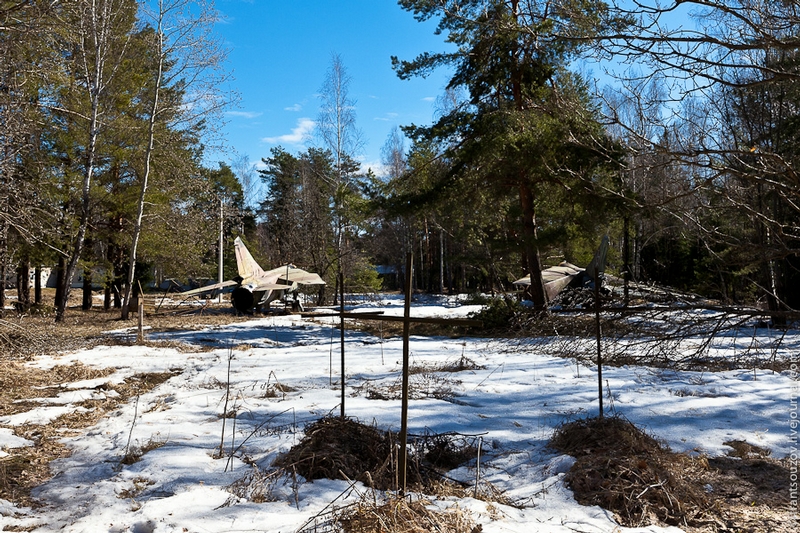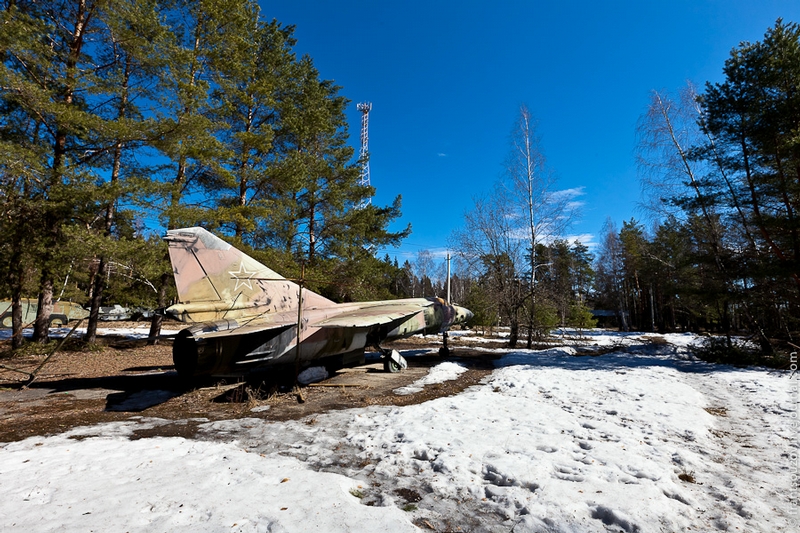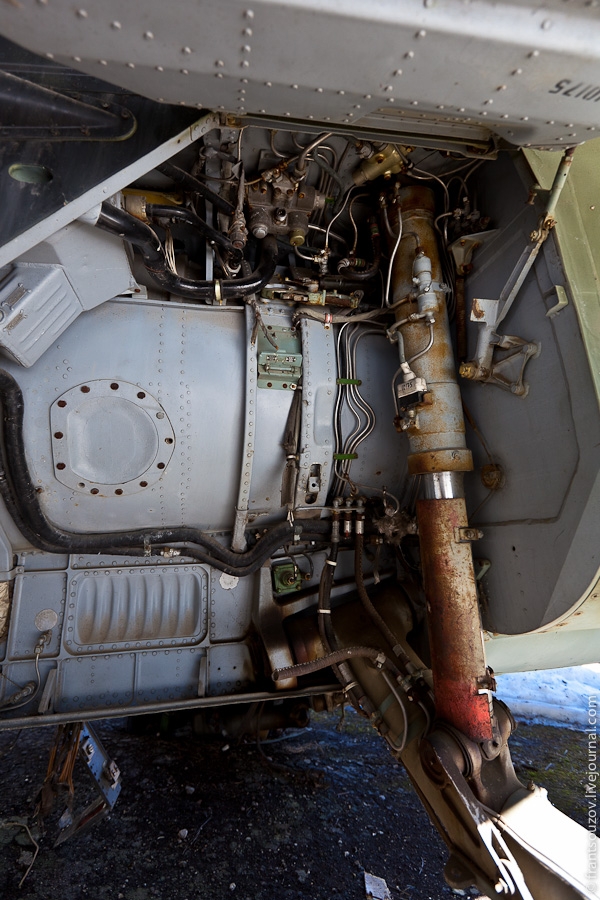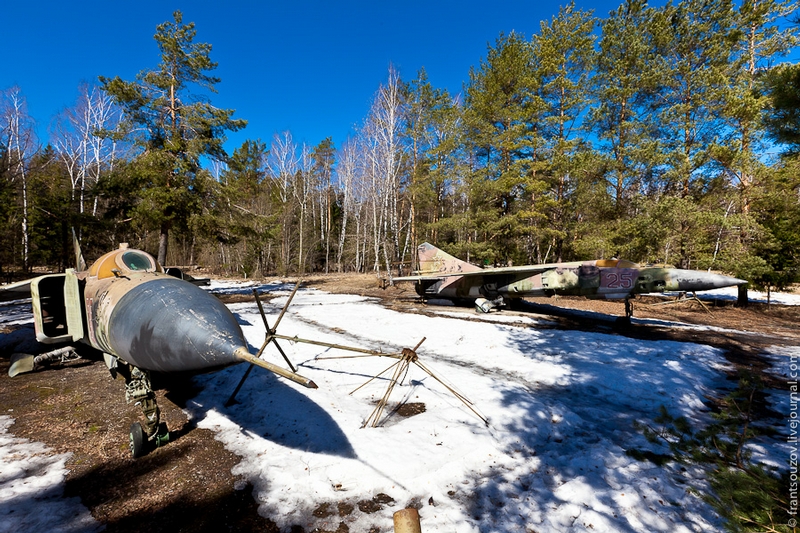Estás usando un navegador obsoleto. No se pueden mostrar estos u otros sitios web correctamente.
Se debe actualizar o usar un navegador alternativo.
Se debe actualizar o usar un navegador alternativo.
Club de los cazas de posguerra sin Club
- Tema iniciado Grulla
- Fecha de inicio

Saludos.
Damian"Grünherz" K.
Colaborador
MiG-23 (32-24B) en Museo Inglés

Consulta, ¿este no es un MiG-27??
Me llama la atención el cono de proa y el tipo de compuertas utilizadas en el tren de aterrizaje principal.
O que alguien me explique la diferencia entre las dos aeronaves...
Saludos!!
Consulta, ¿este no es un MiG-27??
Me llama la atención el cono de proa y el tipo de compuertas utilizadas en el tren de aterrizaje principal.
O que alguien me explique la diferencia entre las dos aeronaves...
Saludos!!
Damián Grulla se va a enojar y te va a decir que no seas vago y lo busques en google.:biggrinjester:
Saludos.
Damian"Grünherz" K.
Colaborador
Bueno en Google me tiro la posta y dice claramente MiG-27 "Flogger D/J".
Y en este caso para que tenemos el foro. Acaso no es un lugar de consulta, donde foristas que saben mas te ayudan a aclara las dudas??:yonofui:
Saludos!!
Y en este caso para que tenemos el foro. Acaso no es un lugar de consulta, donde foristas que saben mas te ayudan a aclara las dudas??:yonofui:
Saludos!!
No te enojes Damián era una joda.
La diferencia entre los dos aviones es que el Mig-23BN es una modificación del Mig.23 para el ataque a tierra el morro es la mayor diferencia, el Mig-27 es un desarrollo tomando de referencia al BN modificándolo con aviónica y armamento especifico para el ataque a tierra y algunas modificaciones en su estructura, tren de aterrizaje y motor.
La forma más fácil de diferenciar a estos dos aviones es el morro.
Mig-23BN

Mig-27

Saludos.
La diferencia entre los dos aviones es que el Mig-23BN es una modificación del Mig.23 para el ataque a tierra el morro es la mayor diferencia, el Mig-27 es un desarrollo tomando de referencia al BN modificándolo con aviónica y armamento especifico para el ataque a tierra y algunas modificaciones en su estructura, tren de aterrizaje y motor.
La forma más fácil de diferenciar a estos dos aviones es el morro.
Mig-23BN

Mig-27

Saludos.
Bueno en Google me tiro la posta y dice claramente MiG-27 "Flogger D/J".
Y en este caso para que tenemos el foro. Acaso no es un lugar de consulta, donde foristas que saben mas te ayudan a aclara las dudas??:yonofui:
Saludos!!
Damián, te la deje servida...solo tenías que poner MiG-23BN en google o wiki.No se si la proa es la principal diferencia porque la misma proa del MiG-27 cambia según la variante.
Pablo, pusiste dos fotos de MiG-27. La primera es un MiG-27 Indio de las primeras versiones. Fijate en la toma de aire y la extensión de la raíz alar
El MiG-23BN fue una versión del MiG-23 de ataque a tierra en la que básicamente se sacaba el radar y equipos asociados y se ponía la proa inclinada.:
Ground-attack variants
MiG-23B ("Flogger-F"): The requirement for a new fighter-bomber had become obvious in the late 1960s, and the MiG-23 appeared to be suitable type for such conversion. The first prototype of the project, "32-34", flew for the first time on 20 August 1970. The MiG-23B had a redesigned forward fuselage, but was otherwise similar to the MiG-23S. The pilot seat was raised to improve visibility, and the windscreen was armored. The nose was flat-bottomed and tapered down. There was no radar; instead it had a PrNK Sokol-23 ground attack sight system, which included an analog computer, a laser rangefinder and the PBK-3 bomb sight. The navigation suite and autopilot were also improved to provide more accurate bombing. It retained the GSh-23L gun, and its maximum warload was increased to 3000 kg by strengthening the pylons. Survivability was improved by an electronic warfare (EW) suite and inert gas system in the fuel tanks to prevent fire. The first prototype had a MiG-23S type wing, but subsequent examples had the larger "type 2" wing. Most importantly, instead of an R-29 variant, aircraft was powered by the Lyulka AL-21 turbojet with a maximum thrust of 11,500 kp. The production of this variant was limited, however, as the supply of AL-21 engines was needed for the Sukhoi Su-17 and Su-24 production lines. In addition, this engine was not cleared for export. Only three MiG-23B prototypes and 24 production aircraft were produced in 1971–72.
MiG-23BK ("Flogger-H") These were exported to Warsaw Pact countries—but not to Third World customers—and thus had the PrNK-23 navigation and attack system. Additional radar warning receivers were also mounted on the intakes.
MiG-23BN ("Flogger-H") Produced since 1973, the MiG-23BN was based on MiG-23B, but had the same R-29-300 engine as contemporary fighter variants. They were also fitted with "type 3" wings. There were other minor changes in electronics and equipment, and some changes were made during its long production run. Serial production lasted until 1985, with 624 built. Most of them were exported, as the Soviets always viewed it as an interim type and only a small number served in Frontal Aviation regiments. As usual, a downgraded version was sold to Third World customers. This variant proved to be fairly popular and effective. The most distinctive identifying feature between the MiG-23B and MiG-23BN was that the former had the dielectric head just above the pylon, which was removed from the MiG-23BN. The last of the MiG-23 BNs were flown by 221 Squadron (Valiants) of Indian Air Force and were decommissioned on 6 March 2009. Wing Commander Tapas Ranjan Sahu, was the last pilot to land the MiG-23 BN on that day.
Pero respecto al MiG-23M y el MiG-23BN el MiG-27 tiene tomas de aire fijas (las de los 23 son de geometría variable), una tobera de motor mas corta y con solo dos posiciones, el MiG-27 tiene placas de blindajes en los laterales del Cockpit y un cañón rotativo de 6 tubos GSh-6-30 de 30 mm en lugar del bitubo de 30 mm de los MiG-23 de caza y ataque.
El MiG-23BN fue ampliamente exportado mientras que el MiG-27 solo lo fue a India en la guerra fria y a Sri Lanka al finalizar esta. Sigue en servicio en India y Bielorrusia, no se en otros paises.
Mas información cortesia de Miguel:
MiG-23:http://www.zona-militar.com/foros/p...as-reaccion-olvidados-o-poco-conocidos-6.html
MiG-27:http://www.zona-militar.com/foros/p...as-reaccion-olvidados-o-poco-conocidos-8.html
Acá un MiG-27 Kazajistan. Se ve el cañon rotativo y el blindaje lateral (donde esta el número 46 amarillo). La toma de aire es mas simple (comparar con la del MiG-23BN abajo

MiG-23B, utilizado para el desarrollo del MiG-23BN


Prototipo del MiG-23BN. Se ve que no tiene la placa de blindaje y la toma de aire es menos compleja, no tiene el separador de capa limite

Damian"Grünherz" K.
Colaborador
Grande Grulla!!!!
Muchas gracias por la información. A eso es lo que yo iba, porque había leido que le 27 estaba basado en el 23 pero no tuvo el éxito que se esperaba. Se lo utilizaba para otro tipo de misiones.
Gracias nuevamente!!
Pablo, no te preocupes que no me enoje. Solamente preguntaba porque para mi era un 27 y como no soy un experto en aviones rusos me queria sacar la duda. Gracias por tu aporte y desasnarme, junto a Grulla, las diferencias entre el 27 y el 23BN.
Saludos a ambos!!
Muchas gracias por la información. A eso es lo que yo iba, porque había leido que le 27 estaba basado en el 23 pero no tuvo el éxito que se esperaba. Se lo utilizaba para otro tipo de misiones.
Gracias nuevamente!!
Pablo, no te preocupes que no me enoje. Solamente preguntaba porque para mi era un 27 y como no soy un experto en aviones rusos me queria sacar la duda. Gracias por tu aporte y desasnarme, junto a Grulla, las diferencias entre el 27 y el 23BN.
Saludos a ambos!!
Damian"Grünherz" K.
Colaborador
El 27 fue el impopular. Solo lo usaron unos pocos paises como bien pusiste vos en este párrafo.
Aprobé? :sifone:
Saludos!!
El MiG-23BN fue ampliamente exportado mientras que el MiG-27 solo lo fue a India en la guerra fria y a Sri Lanka al finalizar esta. Sigue en servicio en India y Bielorrusia, no se en otros paises.
Aprobé? :sifone:
Saludos!!
Me parece que mas viene de la mano de que el MiG-23M/MF/MLD compartian mucho con el MiG-23BN, y que quizas la URSS no lo queria exportar.
De hecho la URSS desplego el MiG-27 en grandes cantidades y del MiG-23BN de ataque solo algunos.
Me tendria que fijar en libro Yefim Gordon o algun otro porque me parece que el MiG-23BN es posterior al MiG-27
De hecho la URSS desplego el MiG-27 en grandes cantidades y del MiG-23BN de ataque solo algunos.
Me tendria que fijar en libro Yefim Gordon o algun otro porque me parece que el MiG-23BN es posterior al MiG-27
También hay que tener en cuenta la tobera fija en el 27
MiG-23MLA o MiG-23MLD armado con R-24R (AA-7C "Apex-C") y R-60 (AA-8 "Aphid") (1988)


Miren lo que aún se puede encontrar en los bosques de Rusia.


















Motocar
Colaborador
Ikarus 452m
Ikarus 452-M, Pequeño avion de caza propuesto por la empresa de Yugoslavia Ikarus, este proyecto se enmarca en la moda de los años cincuenta, (1953 para ser exactos) de cazas ligeros, este en particular era un curioso diseño con motores uno encima del otro y tomas de aire tanto laterales para uno como dorsal para el otro motor, sus prestaciones no fueron muy brillantes pero en cambio su concepcion si, con todas sus superficies de vuelo en flecha positiva, esta propuesta no paso de ser un prototipo.

Blueprint o dibujos de los perfiles del Ikarus 452-M

Exitos a todos
Ikarus 452-M, Pequeño avion de caza propuesto por la empresa de Yugoslavia Ikarus, este proyecto se enmarca en la moda de los años cincuenta, (1953 para ser exactos) de cazas ligeros, este en particular era un curioso diseño con motores uno encima del otro y tomas de aire tanto laterales para uno como dorsal para el otro motor, sus prestaciones no fueron muy brillantes pero en cambio su concepcion si, con todas sus superficies de vuelo en flecha positiva, esta propuesta no paso de ser un prototipo.

Blueprint o dibujos de los perfiles del Ikarus 452-M

Exitos a todos
Temas similares
- Respuestas
- 101
- Visitas
- 8K
- Respuestas
- 54
- Visitas
- 11K
- Respuestas
- 36
- Visitas
- 5K
- Respuestas
- 188
- Visitas
- 23K
- Respuestas
- 3
- Visitas
- 5K













